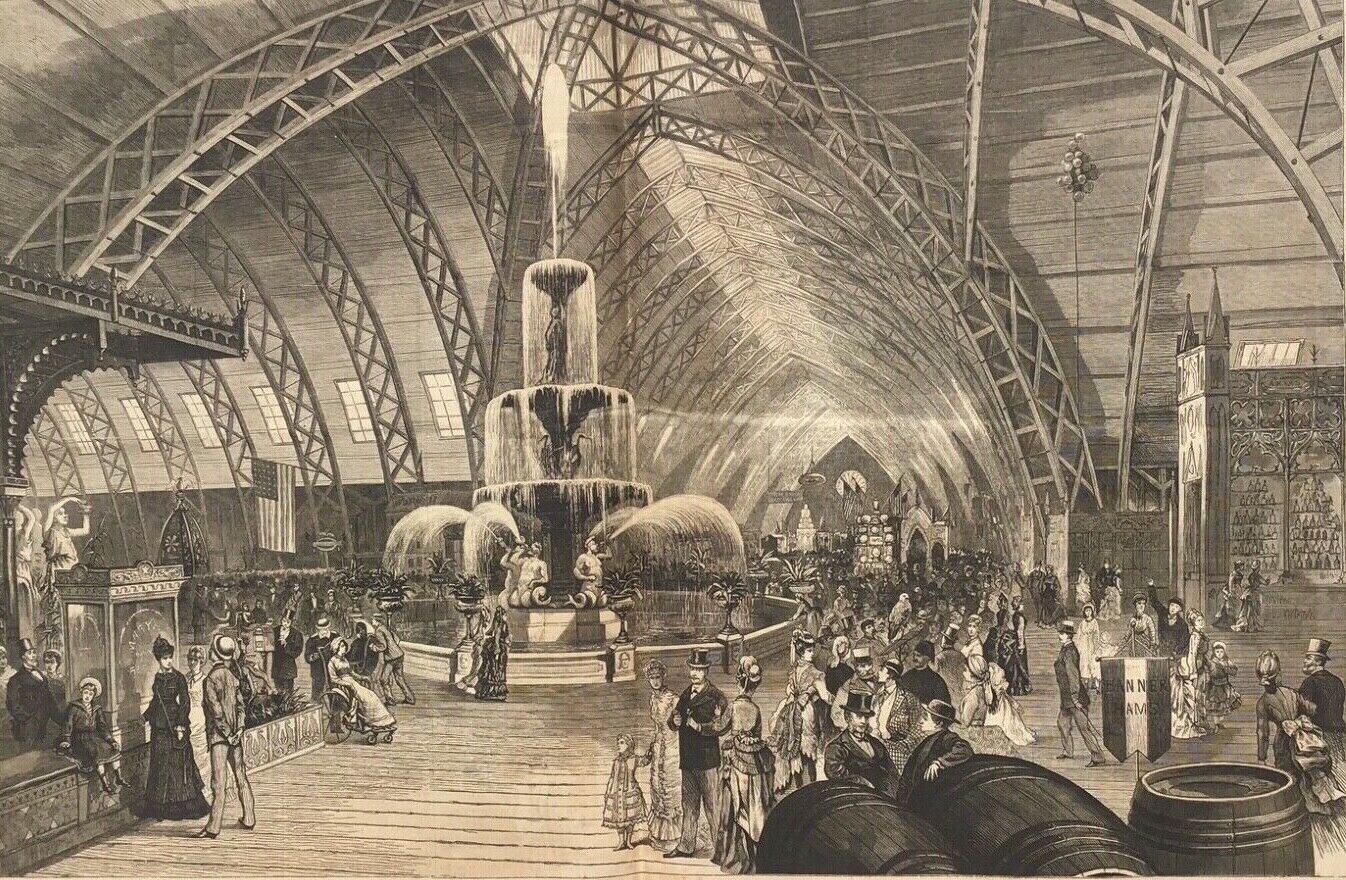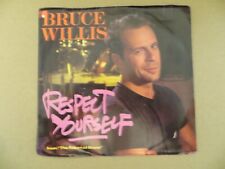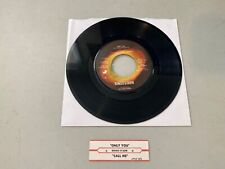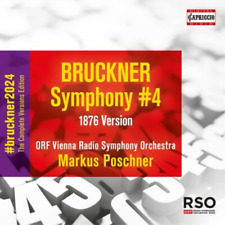
Bands
Bands 0-9 / A
Bands Ba-Bk
Bands Bl-Bz
Bands C
Bands D-E
Bands F-H
Bands I-L
Bands M-O
Bands P-Si
Bands Sm-Sz
Bands T-W
1876 Centennial Exhibition - 5 Harper's Weekly Engravings - Agricultural Hall For Sale
 When you click on links to various merchants on this site and make a purchase, this can result in this site earning a commission. Affiliate programs and affiliations include, but are not limited to, the eBay Partner Network.
When you click on links to various merchants on this site and make a purchase, this can result in this site earning a commission. Affiliate programs and affiliations include, but are not limited to, the eBay Partner Network.
1876 Centennial Exhibition - 5 Harper's Weekly Engravings - Agricultural Hall:
$12.00
A nice collection of five original engravings, published in the Harper's Weekly magazine relating to the Centennial Exposition in Philadelphia and entitled as follows:"Interior of Agricultural Hall" - double page dated September 9,1876 - size 22 x 16 inches
"Kansas and Colorado Exhibit" - full page dated June 17, 1876 - size 11 x 16 inches
"Improvements in Weaving" and " The Murkland Ingrain Carpet Loom" - dated December 16, 1876 - full page size 11 x 16 inches
"State Exhibits in Agricultural Hall" - dated December 16, 1876 - half page size 11 x 8 inches
"Bits from our Artist's Sketchbook" - dated June 3, 1876 - full page size 11 x 16 inches
Good condition - the usual edge tears, creases, age-toning - see scans. Unrelated text to the reverse.
These are original antique prints and not reproductions . Great collectors item for the historian - see more of these in Seller's Other Itemswhich can be combined for mailing.
Centennial ExpositionFrom Wikipedia, the free encyclopediaJump to navigationJump to search"Centennial Exhibition" redirects here. For the 1939–1940 exhibition in Wellington, seeNew Zealand Centennial Exhibition.Centennial International Exhibition of 1876Opening day ceremonies at the Centennial ExpositionOverviewBIE-classUniversal expositionCategoryHistorical ExpoNameCentennial International Exhibition of 1876BuildingMemorial HallArea115 haInvention(s)Typewriter, Sewing machine, StatesCityPhiladelphiaVenueFairmount 1866AwardedJanuary expositionsPreviousWeltausstellung 1873 WieninViennaNextExposition Universelle (1878)inParis
TheCentennial International Exhibitionof 1876, the first officialWorld's Fairto be held in the United States, was held inPhiladelphia,Pennsylvania, from May 10 to November 10, 1876, to celebrate the 100th anniversary of the signing of theDeclaration of Independencein Philadelphia. Officially named theInternational Exhibition of Arts, Manufactures, and Products of the Soil and Mine, it was held inFairmount Parkalong theSchuylkill Riveron fairgrounds designed byHerman J. Schwarzmann. Nearly 10 million visitors attended the exposition, and 37 countries participated in it.
Contents- 1Precursor
- 2Planning
- 3Herman J. Schwarzmann
- 4Structures
- 4.1Main Exhibition Building
- 4.2Agricultural Hall
- 4.3Horticultural Hall
- 4.4Machinery Hall
- 4.5Memorial Hall
- 4.6Women's Pavilion
- 4.7Other buildings
- 5Exposition
- 6Inventions
- 7Exhibits
- 8See also
- 9References
- 10Further reading
- 11External links
TheGreat Central Fairon Logan Square in Philadelphia, Pennsylvania, in 1864 (also known as the Great Sanitary Fair), was one of the manysanitary fairsheld during the Civil War. They provided a creative and communal means for ordinary citizens to promote the welfare of Union soldiers and dedicate themselves to the survival of the nation, and the Great Central Fair bolsteredPhiladelphia's role as a vital centerin the Union war effort. It anticipated the combination of public, private, and commercial investments that were necessary to mount the Centennial Exposition. Both had a similarneo-Gothicappearance, the waving flags, the huge central hall, the "curiosities" and relics, handmade and industrial exhibits, and also a visit from the president and his family.
Planning[edit]The idea of the Centennial Exposition is credited to John L. Campbell, a professor of mathematics,natural philosophy, and astronomy atWabash College,Crawfordsville, Indiana.[1]In December 1866, Campbell suggested toPhiladelphiaMayorMorton McMichaelthat theUnited States Centennialbe celebrated with an exposition in Philadelphia. Naysayers argued that the project would not be able to find funding, other nations might not attend, and domestic exhibits might compare poorly to foreign ones.[2]
TheFranklin Institutebecame an early supporter of the exposition and asked thePhiladelphia City Councilfor use ofFairmount Park. With reference to the numerous events of national importance that were held in the past and related to the city of Philadelphia, the City Council resolved in January 1870 to hold the Centennial Exposition in the city in 1876.[citation needed]
The Philadelphia City Council and thePennsylvania General Assemblycreated a committee to study the project and seek support of theU.S. Congress. CongressmanWilliam D. Kelleyspoke for the city and state, andDaniel Johnson Morrellintroduced abillto create a United States Centennial Commission. The bill, which passed on March 3, 1871, provided that the U.S. government would not be liable for any expenses.
Joseph R. HawleyStock certificate for five $10 shares issued by the Centennial Board of FinanceThe United States Centennial Commission organized on March 3, 1872, withJoseph R. HawleyofConnecticutas president. The Centennial Commission's commissioners included one representative from each state and territory in the United States.[1]On June 1, 1872, Congress created a Centennial Board of Finance to help raise money. The board's president wasJohn Welsh, brother of philanthropist William Welsh, who had raised funds for the Great Sanitary Fair in 1864.[2]The board was authorized to sell up to $10 million in stock via $10 shares. The board sold $1,784,320 ($38,080,363 today[3]) worth of shares by February 22, 1873. Philadelphia contributed $1.5 million and Pennsylvania gave $1 million. On February 11, 1876, Congress appropriated $1.5 million in a loan. Originally, the board thought it was asubsidy, but after the exposition ended, the federal government sued for the money back, and theUnited States Supreme Courtultimately forced repayment. John Welsh enlisted help from the women of Philadelphia who had helped him in the Great Sanitary Fair. A Women's Centennial Executive Committee was formed with Elizabeth Duane Gillespie, a great-granddaughter ofBenjamin Franklin, as president. In its first few months, the group raised $40,000. When the group learned the planning commission was not doing much to display the work of women, it raised an additional $30,000 for a women's exhibition building.[4]
In 1873, the Centennial Commission namedAlfred T. Goshornas the director general of the Exposition. The Fairmount Park Commission set aside 450 acres (1.8km2) of West Fairmount Park for the exposition, which was dedicated on July 4, 1873,[4]bySecretary of the NavyGeorge M. Robeson. The Commission decided to classify the exhibits into seven departments: agriculture, art, education and science, horticulture, machinery, manufactures, and mining and metallurgy. Newspaper publisherJohn W. Forneyagreed to head and pay for a Philadelphia commission sent to Europe to invite nations to exhibit at the exposition. Despite fears of a European boycott andhigh American tariffsmaking foreign goods not worthwhile, no European country declined the invitation.[5]
To accommodate out-of-town visitors, temporaryhotelswere constructed near the exposition's grounds. A Centennial Lodging-House Agency made a list of rooms in hotels,boarding houses, and private homes and then sold tickets for the available rooms in cities promoting the Centennial or on trains heading for Philadelphia.Philadelphia streetcarsincreased service, and thePennsylvania Railroadran special trains from Philadelphia'sMarket Street,New York City,Baltimore, andPittsburgh. ThePhiladelphia and Reading Railroadran special trains from theCenter Citypart of Philadelphia. A small hospital was built on the exposition's grounds by the Centennial's Medical Bureau, but despite aheat waveduring the summer, no mass health crises occurred.[6]
Philadelphia passed an ordinance that authorized Mayor William S. Stokley to appoint 500 men as Centennial Guards for the exposition. Among soldiers and local men hired by the city wasFrank Geyer, best known for investigating one of America's first serial killers,H. H. Holmes.[7][8]Centennial Guards policed exhibits, kept the peace, reunited lost children, and received, recorded, and when possible, returned lost items, the most unusual of which were front hair pieces and false teeth.[9][10][11]Guards were required to live onsite and were housed at six police stations strategically located throughout the Exposition. A magistrate's office and courtroom were located at the only two-story police station located on the grounds and was used to conduct prisoner hearings. Officers slept in cramped quarters, which fostered health issues. Eight guards died while working the Exposition, six fromtyphoid fever, one fromsmallpox, and one from organic disease of the heart.[12][13]
TheCentennial National Bankwas chartered on January 19, 1876, to be the "financial agent of the board at the Centennial Exhibition, receiving and accounting for daily receipts, changing foreign moneys into current funds, etc.," according to an article three days later inThe Philadelphia Inquirer. Its main branch, designed byFrank Furness, was opened that April on the southeast corner ofMarket Streetand 32nd Street. A branch office operated during the exposition on the fairgrounds.[14]The Centennial Commission ran out of funds for printing and other expenses. Philadelphia city officials appropriated $50,000 to make up for the shortfall.[15][16]
Herman J. Schwarzmann[edit]Herman J. Schwarzmann, an engineer for the Fairmount Park Commission, was appointed the main designer of the exposition. In 1869 Schwarzmann had begun working for the Fairmount Park Commission, which administered the site of the 1876 Centennial Exposition. It is one of the great urban parks of America, its importance in landscape history surpassed only by Central Park. Schwarzmann was the chief architect for the Centennial Exposition, designing Memorial Hall, Horticultural Hall, other small buildings, and the landscaping around them. His work for the Centennial Exposition was informed by theVienna International Exposition in 1873, which Schwarzmann visited to study the buildings and the grounds layout. The Vienna International Exposition in 1873 was marred by disastrous logistic planning and was taken as a cautionary example.
At the Vienna Exposition, there was no convenient way for visitors to reach the fairgrounds, and exorbitant rates were charged by carriage drivers. Drawing lessons from this failure, the Philadelphia expo was ready for its visitors, with direct railroad connections to service passenger trains every 30 minutes, trolley lines, street cars, carriage routes, and even docking facilities on the river.
Structures[edit]Map of the Exposition complex.More than 200 buildings were constructed within the Exposition's grounds, which were surrounded by a fence nearly three miles long.[17]There were five main buildings in the exposition. They were the Main Exhibition Building, Memorial Hall, Machinery Hall, Agricultural Hall, and Horticultural Hall. Apart from these buildings, there were separate buildings for state, federal, foreign, corporate, and public comfort buildings. This strategy of numerous buildings in one exposition set it apart from the previous fairs around the world that had relied exclusively on having one or a few large buildings.
The Centennial Commission sponsored adesign competitionfor the principal buildings, conducted in two rounds; winners of the first round had to have details such as construction cost and time prepared for the runoff on September 20, 1873. After the ten design winners were chosen, it was determined that none of them allowed enough time for construction and limited finances.[citation needed]
The architecture of the exposition mainly consisted of two types of building, traditional masonry monuments and buildings with a structural framework of iron and steel.

Related Items:
Bruce Willis – Respect Yourself / Fun Time - 1986 - Motown 1876MF 7" Single VG+
$14.25
RINGO STARR – ONLY YOU / CALL ME 7" VINYL JUKEBOX 45RPM APPLE RECORDS 1876 VG+
$8.99
Anton Bruckner Bruckner: Symphony #4: 1876 Version (CD) Album
$27.81
![]()
Coming Soon
- a teens
- AC/DC
- AKA
- al green
- alan jackson
- Alice Cooper
- Alien Ant Farm
- Allman Brothers, the
- Alton Ellis


